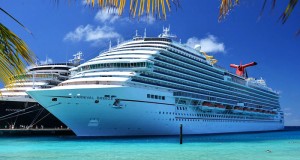It’s a month before the end of the term, stress levels are rising as deadlines draw near and we count down the days before finals start. A holiday cruise seems like a perfect way to unwind and relax during your break from school or work. This was what passengers of Star Princess thought on September 19, 2015 when they boarded their 2-week long cruise to the Hawaiian Islands. Little did they know that they were about to suffer the effects of a Norovirus outbreak. On October 4th 2015, Star Princess docked in Vancouver with a total of 61 passengers who were sickened by Norovirus and displayed symptoms of acute gastroenteritis such as abdominal pain, nausea, vomiting and diarrhea. The Virus was spread through contaminated food, water and personal contact. Earlier this year, the same cruise ship experienced another Norovirus outbreak that affected a total of 135 passengers.
The cruise ship reportedly stopped at several ports where sick passengers were taken to the hospital for further treatment. Several passengers even took a flight back from Hawaii instead of continuing the journey on the cruise. In order to prevent the further spread of the virus, several measures were implemented on the cruise ship:
- Disinfection of hand railings, door handles and elevator buttons
- Hand sanitizers were placed on several locations on the ship
- Infected passengers were isolated from the rest of the passengers
A single food source has not yet been identified for the cause of this outbreak. However, the Food and Drug Administration states that the most common sources of Norovirus include water supply on cruise ships and raw oysters, fruits and vegetables. Once the virus has infected someone, it can be easily transmitted through close contact or cross contamination. A big issue with eating contaminated food on cruise ships is that the sewage and waste produced on cruise ships is dumped 12 miles from the shore. This results in contamination of shellfish that filter-feed around the area where waste was disposed. These contaminated shellfish are then harvested and consumed by people on shore, leading to more infections or outbreaks.
Norovirus outbreaks seem to be a recurring phenomenon on cruise ships with a total of 9 outbreaks recorded in this year alone. But why is Norovirus so notorious for causing outbreaks on cruise ships? Firstly, outbreaks on cruise ships are generally reported more quickly than outbreaks on land. Cruise ships also provide an ideal condition for the spread of Norovirus as it is an enclosed environment that increases the amount of person-to-person contact within the shared living space. The common source of food and drinks also facilitates the spread of Norovirus infection. Lastly, about a third of the passengers on cruise ships are elderly people who are more susceptible to Norovirus infections, which results in a greater incidence of infection.
Due to the high occurrence of this issue on cruise ships, Centers for Disease Control (CDC) has created a surveillance and reporting system to prevent and reduce the risk of spreading gastrointestinal illnesses. CDC’s Vessel Sanitation Program monitors the magnitude and distribution of cases reported, helps to implement sanitation procedures, makes recommendations for control of the pathogen and conducts investigations to determine the causative agent. If the illness rate on board the cruise is 3% or more, an investigation is performed through 3 main steps:
1) Epidemiological investigation: Measures the size of the outbreak through questionnaires, medical records and cruise ship layout.
2) Laboratory investigation: Specimens collected from infected passengers to confirm the pathogen responsible.
3) Environmental investigation: Uses information from the epidemiological investigation and further investigations to determine the source of infection.
After learning about the occurrence of Norovirus outbreaks on cruise ships, would you still consider going on a cruise? Can you think of any other ways that this issue can be prevented?
Sources:
Bert, F., Scaioli, G., Gualano, M. R., Passi, S., Specchia, M. L., Cadeddu, C.. . Siliquini, R. (2014). Norovirus outbreaks on commercial cruise ships: A systematic review and new targets for the public health agenda. Food and Environmental Virology, 6(2), 67-74.
Centers for Disease Control and Prevention. (2015). Outbreak updates for international cruise ships. Retrieved from http://www.cdc.gov/nceh/vsp/surv/gilist.htm#2015
Centers for Disease Control and Prevention. (2015). Outbreak Investigation Overview. Retrieved from http://www.cdc.gov/nceh/vsp/surv/investigationoverview.htm
Canadian Broadcasting Corporation News. (2015). Norovirus hits Star Princess, delays massive cruise ship in Vancouver. Retrieved from http://www.cbc.ca/news/canada/british-columbia/star-princess-cruise-norovirus-hawaii-vancouver-b-c-outbeak-1.3255632
International Business Times. (2015). Cruise Ship Norovirus Outbreak 2015: Dozens of Star Princess Passengers Sickened By Stomach Bug. Retrieved from http://www.ibtimes.com/cruise-ship-norovirus-outbreak-2015-dozens-star-princess-passengers-sickened-stomach-2127270

